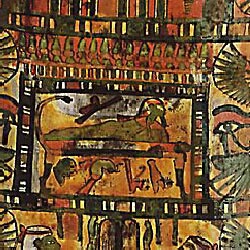| |
|

|
 |
 |


|
 |

1085-710 B.C. (21st-24th Dynasty)
Painted and varnished linen
The William Hood Dunwoody Fund
|
Look
Osiris was the first Egyptian to be mummified and he appears three times on this mummy case.
How has the artist shown that Osiris was mummified? Hint: Look at the lower half of his body.

|
Detail of Osiris from the Mummy Case Of Lady Teshat |
|
- What colors did the artist use to depict Osiris in this image? Look at his hands and face. Is this a natural skin color?
- An outline is a line that describes the outside edge of an object or figure.
Where do you see outlines in the figure of Osiris?
Torso and legs, crown, face, wrists, and hands.
Does the outline make the figure of Osiris appear flat or THREE-DIMENSIONAL?
Heavy outlines weight the figure down and make it appear flat.
- An ATTRIBUTE
is a distinctive symbolic feature that identifies a character. Find Osiris's
attributes: mummy wrappings, throne, shepherd's crook and whip, red crown with ostrich plume, and beard.
Do you think you could identify Osiris by his face alone, without his attributes? Why or why not?
Egyptian figural STYLE
is standardized. Human figures generally look the same. They have no distinct individual characteristics.
Think
- Osiris is god of vegetation, god of the Underworld, and god of the moon.
Which of these roles do you think his green skin refers to?
God of vegetation.
In what ways does green suggest life and growth?
The color green in plants indicates life; green is associated with spring, a time of growth.
- Why do you think it was important to have Osiris represented on this mummy case? Recall Osiris's role as god of the Underworld. How
did Osiris help the ka in its passage to the Underworld?
- Do you think the Egyptian artist who painted this mummy case was interested in showing us what Osiris really looked like, in telling his story, or in showing us his special powers?
Explain your answer.
Parts of Osiris's story are recalled in his mummy wrapping and green skin. Special powers are identified by his attributes: throne,
shepherd's crook and whip, crown with ostrich plume, and beard. Individual characteristics are unimportant in Egyptian figural
style.
|
|
|











